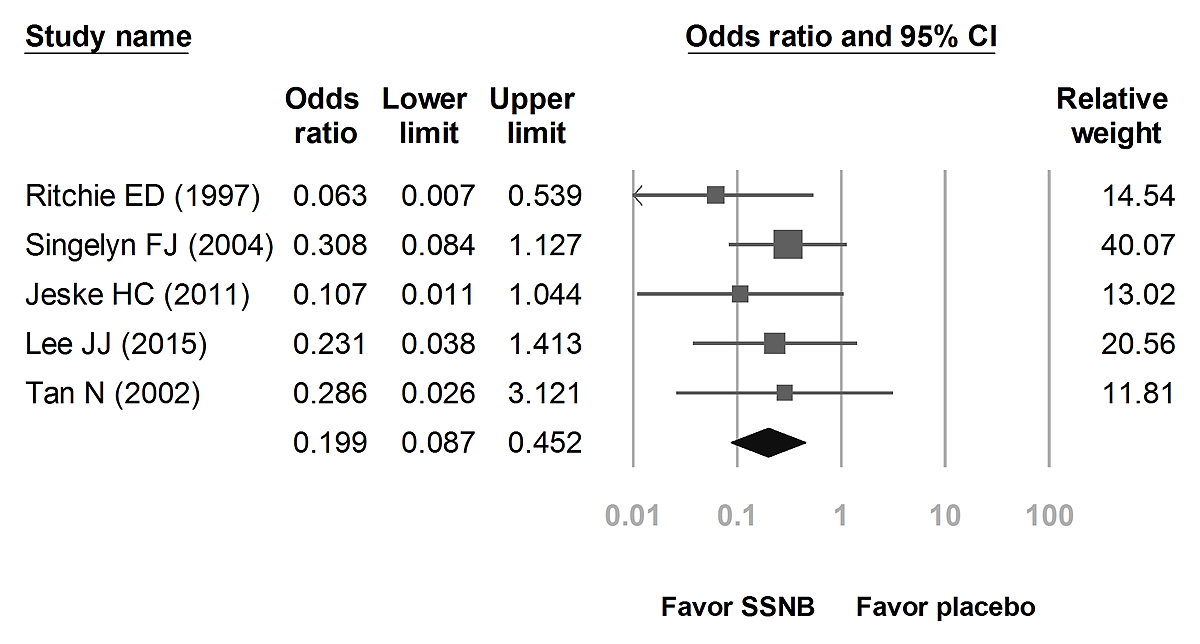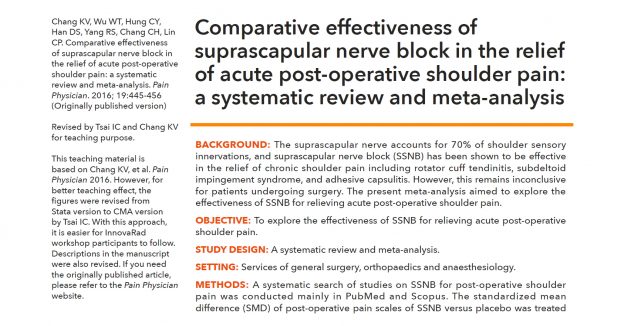
指定論文版權說明
《統合分析工作坊》的指定論文比較特別,我們是以張凱閔醫師團隊,發表於 Pain Physician 的文章為基礎,將原本以 Stata 分析的部分,全部改為更為親民的工作坊指定軟體 CMA。
因為兩個軟體的呈現流程、視覺優化重點與小數點位數等細節均不相同,處理上花了蠻多功夫。為了讓各位的學習能更為流暢,減少學習障礙,一切都值得。
新思惟國際,尊重各種形式的智慧財。所以,我們取得張凱閔醫師同意後,拿到論文的 MS-Word 版本原稿重新編輯,也委請設計師,用不同的風格,重新排版過。版權由「新思惟國際」回贈給張凱閔醫師,並均能獨立使用。
這份論文,將作為這次工作坊的教材。也歡迎您在課堂上,隨時與原作者詢問討論。

論文故事
肩膀的感覺神經分布,約有 7 成由 suprascapular nerve(肩胛上神經)負責。所以,會造成肩膀疼痛的疾病,如 rotator cuff tendinitis, subdeltoid impingement syndrome 以及 adhesive capsulitis 等,都可以用 suprascapular nerve block(SSNB;肩胛上神經阻斷術)有效緩解。
不過,SSNB 對於手術後的肩膀疼痛,是否有一樣的效果,目前未知。
本研究預計回顧既有文獻,做統合分析,瞭解 SSNB 對於手術造成的肩膀疼痛,是否有緩解效果。預計收入研究的手術,包括「會造成肩膀疼痛」的各種手術,如:shoulder surgery 與 non-shoulder surgery (laparoscopic surgery / thoracotomy)。
所研究的重點,是以 SSNB 與 placebo 組之疼痛程度,作為 primary outcome;手術後的 nausea(噁心感)程度,作為 secondary outcome。
經過搜尋,共有 7 個 randomized controlled trials 以及 2 個 comparative studies,收入共 681 個受試者。
結果發現,使用 SSNB,比起 placebo,術後疼痛明顯較少,不過這樣的緩解效果,只存在於 shoulder surgery 組,non-shoulder surgery 則沒有這樣的效果。另外,使用 SSNB,可以有效緩解患者的術後 nausea。
根據本研究,日後對於 shoulder surgery,可考慮使用 SSNB 作為例行止痛策略的一環,但對於 non-shoulder surgery,即使引起肩膀疼痛,也不建議使用 SSNB 止痛。
原刊登版本
Chang KV, Wu WT, Hung CY, Han DS, Yang RS, Chang CH, Lin CP. Comparative effectiveness of suprascapular nerve block in the relief of acute post-operative shoulder pain: a systematic review and meta-analysis. Pain Physician. 2016; 19:445-456
原文摘要
BACKGROUND: The suprascapular nerve accounts for 70% of shoulder sensory innervations, and suprascapular nerve block (SSNB) has been shown to be effective in the relief of chronic shoulder pain including rotator cuff tendinitis, subdeltoid impingement syndrome, and adhesive capsulitis. However, this remains inconclusive for patients undergoing surgery. The present meta-analysis aimed to explore the effectiveness of SSNB for relieving acute post-operative shoulder pain.
OBJECTIVE: To explore the effectiveness of SSNB for relieving acute post-operative shoulder pain.
STUDY DESIGN: A systematic review and meta-analysis.
SETTING: Services of general surgery, orthopaedics, and anaesthesiology.
METHODS: A systematic search of studies on SSNB for post-operative shoulder pain was conducted mainly in PubMed and Scopus. The standardized mean difference (SMD) of post-operative pain scales of SSNB versus placebo was treated as the primary outcome, whereas the odds ratio of nausea of SSNB versus placebo comprised the secondary outcome.
RESULTS: The meta-analysis included 7 randomized controlled trials and 2 comparative studies comprising 681 participants in total. The quantitative analysis showed a significantly lower pain level of SSNB versus placebo in the shoulder surgery patient group (SMD: -0.33; 95% confidence level [CI]: -0.51 to -0.15), but not in the non-shoulder surgery group (SMD: 0.28; 95% CI: -0.37 to 1.93). The pooled odds ratio of nausea in the SSNB arm compared with the placebo arm was 0.20 (95% CI: 0.09 to 0.45), indicating a reduction in the incidence of nausea following SSNB.
LIMITATIONS: Heterogeneity of included trials.
CONCLUSIONS: SSNB significantly reduced acute post-operative shoulder pain in the shoulder surgery group but not in patients undergoing laparoscopic surgery or thoracotomy. This suggests that SSNB can be used as a method of polymodal analgesia for patients undergoing shoulder surgery; however, it is not recommended for the non-shoulder surgery patient population.
KEY WORDS: Suprascapular nerve, shoulder surgery, thoracotomy, laparoscopic surgery.
最新活動

